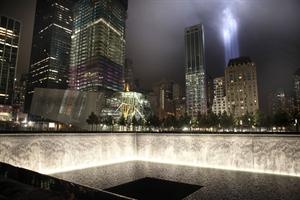
Source: Credit: Fisher Marantz Stone
National September 11 Memorial: Two 200-foot-square, illuminated pools mark the footprints of New York’s twin towers.
Breakthroughs in LED and lighting control technology have made it possible to light spaces using much less energy, with much longer service life. Not only do these new technologies (we haven’t even seen the real emergence of OLED - yet) mean less energy use, but light can take forms never before thought possible.
Yet there seems to me to be a division between the world’s most prominent lighting designers and the rest of the lighting industry. While LED manufacturers, fixture makers and lighting control companies are eagerly selling the green aspects of their products, some of the world’s most prominent designers are actively fighting against the sustainability movement.
In the US, there are leading lighting designers who are dead set against reducing lighting choice through the incandescent phase out. For many their credits and reputation in the industry are beyond reproach and they leverage them to fight progress by writing at great length on the subject, and have even personally emailed me to make their case against any kind of incandescent phase out.
I thought the ‘preservation of personal freedom’ argument was uniquely American, but there are European designers who are no less public in their opposition to Europe’s incandescent phase out. Such protests lead to stockpiling of incandescent bulbs in the name of lighting choice.
The problem here is twofold. When lighting designers put a stake in the ground to fight sustainability and the green movement, what they are saying is that today’s lighting is more important than tomorrow’s future.
Moreover, when these prominent speakers speak out against a future of shared sacrifice, it presents a vision to the public of lighting design as an archaic practice - one obsessed with burning tungsten when there are better technologies available.
Of course these designers don’t speak for all lighting designers. In fact, the best work happens when lighting designers collaborate with LED manufacturers to create lighting that is beautiful and sustainable.
A recent example in the US is the World Trade Centre Memorial by Fisher Marantz Stone.
Here a completely original water-cooled LED system had to be developed as a collaboration between lighting designers and Winona lighting.
That’s the future of lighting design - designers working with manufacturers to develop fixtures that create perfect lighting solutions. I’d like to see a future where this collaboration didn’t just happen on the world’s foremost projects, but on the products that might illuminate the average home or office.
Yes, there is a lot of bad LED out there, but that’s because lighting designers aren’t there to stop these sub-standard products from hitting the market. Yes, there are lousy CFLs out there, but as an industry we’re not teaching homeowners about the possibilities of halogen and LED.
If lighting designers do not stake out a place as educators and information brokers to the public, we will surrender possession of that ground to others.
The answer isn’t to simply fight the future, it’s to embrace it and take a hand in shaping it. Only then will the design community help the industry create products that reduce energy consumption, while at the same time creating beautiful, sustainable light for all.
Do you think lighting designers are failing to do enough to support energy-efficient lighting and the sustainability movement?





